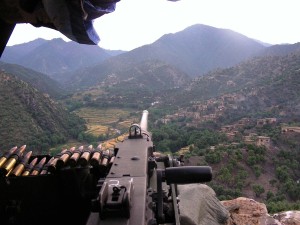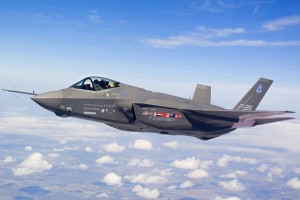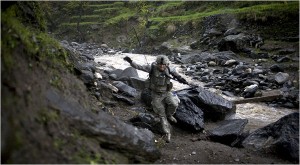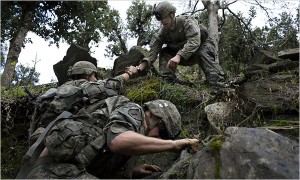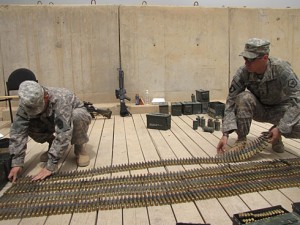Only the lead insurgents were disciplined as they walked along the ridge. They moved carefully, with weapons ready and at least five yards between each man, the soldiers who surprised them said.
Behind them, a knot of Taliban fighters walked in a denser group, some with rifles slung on their shoulders — “pretty much exactly the way we tell soldiers not to do it,” said Specialist Robert Soto, the radio operator for the American patrol.
If these insurgents came close enough, the soldiers knew, the patrol could kill them in a batch.
Fight by fight, the infantryman’s war in Afghanistan is often waged on the Taliban’s terms. Insurgents ambush convoys and patrols from high ridges or long ranges and slip away as the Americans, weighed down by equipment, return fire and call for air and artillery support. Last week a patrol from the First Infantry Division reversed the routine.
An American platoon surprised an armed Taliban column on a forested ridgeline at night, and killed at least 13 insurgents, and perhaps many more, with rifles, machine guns, Claymore mines, hand grenades and a knife.
The one-sided fight, fought on the slopes of the same mountain where a Navy Seal patrol was surrounded in 2005 and a helicopter with reinforcements was shot down, does not change the war. It was one of hundreds of firefights that have occurred in the Korangal Valley, an isolated region where local insurgents and the Americans have been locked in a bitter stalemate for more than three years.
But as accounts of the fight have spread, the ambush, on Good Friday, has become an emotional rallying point for soldiers in Kunar Province, who have seen it as a both a validation of their equipment and training and a welcome bit of score-settling in an area that in recent years has claimed more American lives than any other.
The patrol, 30 soldiers from the First Battalion, 26th Infantry, had left this outpost before noon on April 10, and spent much of the day climbing a ridge on the opposite side of the Korangal River, according to interviews with more than half the participants.
Once the soldiers reached the ridge’s crest, almost 6,000 feet above sea level on the side of a peak called Sautalu Sar, they found fresh footprints on the trails, and parapets of rock from where Taliban fighters often fire rifles and rocket-propelled grenades down onto this outpost.
The platoon leader, Second Lt. Justin Smith, selected a spot where trails intersected, and the platoon dug shallow fighting holes before dark. Claymore antipersonnel mines were set among the trees nearby.
At sunset, Lieutenant Smith called for a period of absolute silence, which lasted into darkness. Then he ordered three scouts to sit in a listening post about 100 yards away, 10 feet off the trail.
The scouts set in. Less than a half-minute later, a column of Taliban fighters appeared, walking briskly their way.
Sgt. Zachary R. Reese, a sniper, whispered into his radio. “We have eight enemy personnel coming down on our position really fast,” he said. He could say no more; the Taliban fighters were a few feet away.
More appeared. Then more still. The sergeant counted 26 gunmen pass by.
The patrol, Second Platoon of Company B, was in a place where no Americans had spent a night for years, and it seemed that the Afghans did not expect danger.
The soldiers waited. The rules of the ambush were long ago drilled into them: no one can move, and no one can fire until the patrol leader gives the order. Then everyone must fire at once.
The third Taliban fighter in the column switched on a flashlight, the soldiers said, and quickly switched it off. About 50 yards separated the two sides, but Lieutenant Smith did not want to start shooting too soon, he said, “because if too many lived then we’d be up there fighting them all night.”
He let the Taliban column continue on. The soldiers trained their weapons’ infrared lasers, which are visible only with night-vision equipment, on the fighters as they drew closer. The lasers mark the path a bullet will fly.
The lead fighter had almost reached the platoon when Pvt. First Class Troy Pacini-Harvey, 19, his laser trained on the lead man’s forehead, moved his rifle’s selector lever from safe to semi-automatic. It made a barely audible click. The Taliban fighter froze. He was six feet away.
Lieutenant Smith was new to the platoon. This was his fourth patrol. He was in a situation that every infantry lieutenant trains for, but almost no infantry lieutenant ever sees. “Fire,” he said, softly into the radio. “Fire. Fire. Fire.”
The platoon’s frontage exploded with noise and flashes of light as soldiers fired. Bullets struck all of the lead Taliban fighters, the soldiers said. The first Afghans fell where they were hit, not managing to fire a single shot.
Five Taliban fighters bolted to the soldiers’ left, unwittingly running squarely into the path of machine-gun bullets and the Claymore mines. For a moment, the soldiers heard rustling in the brush. They detonated their Claymores and threw hand grenades. The rustling stopped.
Two other Taliban fighters had dashed to the right, toward an almost sheer drop. One ran so wildly in the blackness that his momentum carried him off the cliff, several soldiers said.
Another stopped at the edge. Pvt. First Class Brad Larson, 19, had followed the man with his laser. “I took him out,” he said.
The scout at the listening post shot three of the fleeing fighters, and dropped two more with hand grenades. “We stopped what we could see,” Sergeant Reese said.
The shooting had lasted a few minutes. The hillside briefly fell quiet. The surviving Taliban fighters, some of whom had run back up the trail, began shouting in the darkness. “We could hear them calling out to one another,” Specialist Soto said.
Lieutenant Smith called the listening post back in. After two Apache attack helicopters showed up, an F-15 dropped a bomb on the Taliban’s escape route, about 600 yards up the trail. Then the lieutenant ordered teams to search the bodies they could find on the crest.
Sergeant Reese gave his rifle to another sniper to cover him while he tried to cut away a Taliban fighter’s ammunition pouches with a four-inch blade. The fighter had only been pretending to be dead, the soldiers said. He lunged for Sergeant Reese, who stabbed him in the left eye.
In all, the soldiers found eight bodies on the crest. They photographed them to try to identify them later, and collected their weapons, ammunition, radios and papers. Then the patrol swept down a gully where a pilot said he saw more insurgents hiding.
Four scouts, using night-vision gear, spotted five fighters crouching behind rocks, and killed them with rifle and machine-gun fire, the scouts said. The bodies were searched and photographed, too. The platoon began to hike back to the outpost, carrying the captured equipment.
Second Platoon, Company B has endured one of the most arduous assignments in Afghanistan. Eight of the platoon’s soldiers have been wounded in nine months of fighting in the valley, part of a bitter contest for control of a small and sparsely populated area.
Three others have been killed.
In a matter of minutes, the ambush changed the experience of the surviving soldiers’ tours. The degree of turnabout surprised even some the soldiers who participated.
“It’s the first time most of us have even seen the guys who were shooting at us,” said Sgt. Thomas Horvath, 21.
The next day, elders from the valley would ask permission to collect the villages’ dead. Company B’s commander, Capt. James C. Howell, would grant it.
But already, as the soldiers slid and climbed down the mountain, word of the insurgents’ defeat was traveling through Taliban networks.
Thanks to Chivers and Hicks for a great article on the campaign in Afghanistan. Abu Muqawama gives the unit props, but asks the following question: “But what are we doing in the Korengal (sic) Valley? Does anyone know? Are we just trying to control the terrain or what?” Good question. There has been a robust debate concerning where the additional troops should go in Afghanistan – the urban population centers where the people are, or the rural areas where the Taliban control and recruit? A good question, this, because it goes to the heart of the population-centric counterinsurgency doctrine promulgated over the last several years.
And in a hard situation in Afghanistan where we have both large rural areas and urban areas containing much of the population, how does this doctrine hold up? Well, it at least leads to very puzzled questions from COIN experts. It also shows that counterinsurgency cannot possibly be codified in a manual, no matter how hard we may try.
At times this will be extremely difficult, with the insurgency embedding with the population, shielding themselves with women and children, and hiding from U.S. forces. Counterinsurgency thus proves to be a difficult mix of direct action military engagements, streetside conversations, visits to homes, learning the population and culture, and rebuilding the infrastructure. There will be enough of this to go around for everyone in the campaign.
But just occasionally, the insurgents will separate themselves from the population, attempt to mass on a location, and go into conventional military formation. When this happens and when U.S. forces can find it, it pays to kill them on the spot whether they are a direct threat or not.
Why are U.S. forces present in the Korangal valley? The obvious answer is to kill the enemy. It’s the perfect circumstances, crafted by the insurgents themselves. No women, no children, no surrounding infrastructure to be destroyed, only the enemy and U.S. troops. We dread the difficulty of population-centric counterinsurgency and pray for such engagements.
Such engagements are not to be found in the urban population centers. Interdiction of enemy fighters and enemy-centric warfare can best be conducted when we are hunting and killing the enemy with enough troops to accomplish success.
There are other aspects of this engagement that warms our hearts. Notice that despite the rules of engagement which do not discuss or countenance offensive operations at all, U.S. forces killed enemy fighters without first waiting for them to threaten or fire on them. Notice also that the U.S. combatants are regular infantry. Just so. The campaign will be won or lost with regular infantry, not direct action by Special Operations Forces on so-called high value targets, a strategy that has not succeeded in the campaign for as long as it has been pursued.
